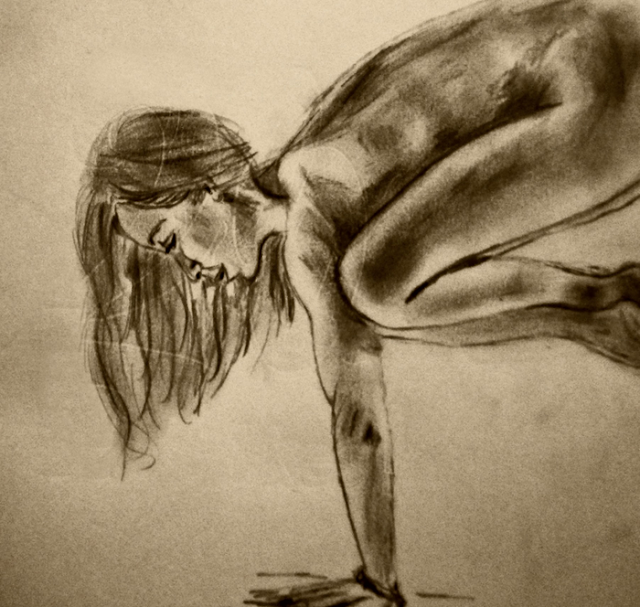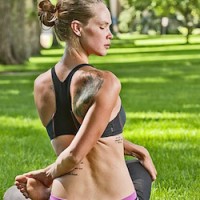I consider myself lucky in my work; I work with the most intimate parts of people.
Their worries, their laughter, their tears, their joys, their vulnerability, their strength.
It comes through as they move, and as I assist their bodies.
When I place my hands on them as they hold a stretch and I gently apply pressure on their muscles to offer the support that is sometimes needed for a release, I find intimacy in the way their body gives way to mine, the way my fingers and my hands mold to them, the way they trust me enough to let this happen.
I am careful and thoughtful and approach people with a unique knowledge of the body.
I recently took a partner yoga class with a friend. The class was filled with couples loving the moments they got to touch the person they love so deeply, learning one another’s movements and communicating needs for proper use of the other’s weight.
I love the body for this reason—it is so tangible and so specific to how each person is doing. You can tell the stress, apprehension, joy and love that person is feeling at the moment by the way the muscles release and give way to resistance and pressure, or stay stiff and tight as they resist letting you in. You learn to adapt accordingly, whether consciously or subconsciously. You learn how to be there for someone without words.
And the more that both parties relax and give way to the other, the more profound the efficiency and the function is.
The way that I was trained to see the body is atypical.
I was not taught the names of muscles and bones, but rather the chain of command, where weakness ends and strength begins, how to recover as well as how to defend. I see the body in a series of doorways and access points, and this helps me to see its present mental and the physical state.
Let’s take a look at the body:
The chin, jaw and neck.
They, like the other parts of the body we will talk about, hold a lot of stress. You can see the way that someone clamps their jaw shut, the way the neck muscles tighten, and how the chin either protrudes or recedes (generally it protrudes) when someone is not saying something they want or need to. The chin leads forward when we rush, that lead causes us to “fall” forward in our steps and leave posture far behind. It lifts when we do not want to humble ourselves and drops when we are feeling less than our best.
This tightness extends into the neck, which also leads down into our shoulders, upper back and chest. We carry things here, we shrug or pull back too much, refusing to accept this area in its neutral state, insisting on “opening the heart,” or, for that matter, closing it off. Rounded shoulders indicate a lack of care and confidence, a sense of defeat. Pulled back shoulders and an over exposed chest is compensation for what we feel like we are lacking, also known as peacocking. If you do not know what I mean, look at a frat boy around his bros.
Our low back and hips are our stability.
Look at the curvature in the low back: do you stick your butt out too far or do you push your pelvis forward and allow your belly to go? Neither of these is balanced. In fact, they are both deficiencies in strength. If you cannot engage your core to support your low back, where is your stability coming from? Your muscular and nervous system are incredibly closely linked, so your emotions will play out in the weak points of your physical body.
Knees.
So many people lock them out, hanging out on the joint rather than engaging the muscles. This lock out indicates a lack of flexibility, locking out the hip joint and the sacrum, creating a lack of mobility in those areas.
What do our legs do? They stand our ground, confidently or insecurely. Our knees are the first major joint stemming up from the ground, making them one of the most important. We destroy them with improper technique and a refusal to admit that they may ever fail us, as a result of us failing them. Slight pain is one of the first signs of this destruction, but often we do not listen because we are too set in our ground to believe that we could be taken down by something as simple as a knee.
The feet.
This is my favorite part of the body, because this is where it all begins. They are what we stand on, they support everything upward of them, they are brilliant. If there is any doubt, study the back chain coming from the plantar fascia—it’s fascinating.
Did you know that most people with chronic tightness in their back can begin to address it by gently rolling the bottom of their foot over a tennis ball for a few minutes on each side, which loosens up the plantar fascia, leading up the back of the leg to the hip, into the sacrum and through out the spine into the neck?
We point them in and out, stand on one and then the other, shifting our stance constantly. Does this mean we are afraid to stand on our own two feet? Perhaps.
But, these relationships don’t need to be emotional or mental, we can simply just look at the physical if that is what helps you to see your body as a puzzle, with pieces to be connected and pieced together slowly and efficiently.
Physical alignment according to each individuals body is important for both prevention and recovery of injuries.
It is intimate to move and touch a person’s body, especially when approaching it not just from a physical aspect, but from the knowledge of what an excessive or deficient use of a muscle is caused by. If you slow down and think methodically through what the muscles and the joints do, what the movement opens and closes, stretches and compresses you can start to understand the body on a different level.
We can see a series of chain reactions, recognizing that the localization of pain is not actually localized, but generally stemming from a deeper issue. Your practice and your ability to touch will become more connected to who that person is and where they are in their life.
As a teacher, it is easy to get lost in our own expectations of where we think the students should go in their pose, but this generally stems from looking at the pose rather than at the whole person and their postural habits. To me, this is the brilliance of the body and how we begin to heal, connect,and truly change where we are.
Yoga means to yoke, we all know this. Yoke, unity, connection…it all equals intimacy.
To be intimate we have to be willing to slow down and pay attention to the resistance, the tightness, the flexibility of a person as a whole. As students, it is easy to believe that we should open our hearts and pull our shoulders back to do so, but an open heart stems from truly connecting to where we are first, being honest about our state of being.
This intimacy I talk about is not sexual, it is deeper than that—it is a knowledge and understanding of where each person sits at any given moment, which sounds a lot like the definition of Namaste.
Love elephant and want to go steady?
Sign up for our (curated) daily and weekly newsletters!
Author: Adriane Ehmann
Editor: Emily Bartran
Photo: Pixoto







Read 0 comments and reply